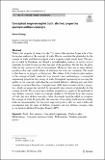Conceptual engineering for truth : aletheic properties and new aletheic concepts
Abstract
What is the property of being true like? To answer this question, begin with a Canberra-plan analysis of the concept of truth. That is, assemble the platitudes for the concept of truth, and then investigate which property might satisfy them. This project is aided by Friedman and Sheard’s groundbreaking analysis of twelve logical platitudes for truth. It turns out that, because of the paradoxes like the liar, the platitudes for the concept of truth are inconsistent. Moreover, there are so many distinct paradoxes that only small subsets of platitudes for truth are consistent. The result is that there is no property of being true. The failure of the Canberra plan analysis of the concept of truth, points the way toward a new methodology: a conceptual engineering project for the concept of truth. Conceptual engineering is assessing the quality of our concepts, and when they are found defective, offering new and better concepts to replace them for certain purposes. Still, there are many aletheic properties, which are properties satisfied by reasonably large subsets of platitudes for the concept of truth. We can treat these aletheic properties as a guide to the multitude of new aletheic concepts, which are concepts similar to, but distinct from, the concept of truth. Any new aletheic concept or team of concepts might be called on to replace the concept of truth. In particular, the concepts of ascending truth and descending truth are recommended, but the most important point is that we need a full-scale investigation into the space of aletheic properties and new aletheic concepts—that is, we need an Aletheic Principles Project (APP).
Citation
Scharp , K 2020 , ' Conceptual engineering for truth : aletheic properties and new aletheic concepts ' , Synthese , vol. First Online . https://doi.org/10.1007/s11229-019-02491-4
Publication
Synthese
Status
Peer reviewed
ISSN
0039-7857Type
Journal article
Collections
Items in the St Andrews Research Repository are protected by copyright, with all rights reserved, unless otherwise indicated.

